Peanut
The peanut, also known as the groundnut,[2] goober (US), or monkey nut (UK), and taxonomically classified as Arachis hypogaea, is a legume crop grown mainly for its edible seeds. It is widely grown in the tropics and subtropics, being important to both small and large commercial producers. It is classified as both a grain legume[3] and, due to its high oil content, an oil crop.[4] World annual production of shelled peanuts was 44 million tonnes in 2016, led by China with 38% of the world total. Atypically among legume crop plants, peanut pods develop underground (geocarpy) rather than above ground. With this characteristic in mind, the botanist Carl Linnaeus named the species hypogaea, which means "under the earth".
| Peanut | |
|---|---|
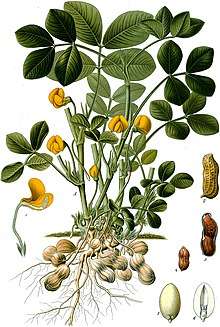 | |
| Scientific classification | |
| Kingdom: | Plantae |
| Clade: | Tracheophytes |
| Clade: | Angiosperms |
| Clade: | Eudicots |
| Clade: | Rosids |
| Order: | Fabales |
| Family: | Fabaceae |
| Genus: | Arachis |
| Species: | A. hypogaea |
| Binomial name | |
| Arachis hypogaea | |
| Subspecies and varieties | |
| |
| Synonyms[1] | |
| |
As a legume, the peanut belongs to the botanical family Fabaceae; this is also known as Leguminosae, and commonly known as the bean, or pea, family.[1] Like most other legumes, peanuts harbor symbiotic nitrogen-fixing bacteria in root nodules.[5] This capacity to fix nitrogen means peanuts require less nitrogen-containing fertilizer and also improve soil fertility, making them valuable in crop rotations.
Peanuts are similar in taste and nutritional profile to tree nuts such as walnuts and almonds, and as a culinary nut are often served in similar ways in Western cuisines. The botanical definition of a "nut" is a fruit whose ovary wall becomes hard at maturity. Using this criterion, the peanut is not a typical nut.[6] However, for culinary purposes and in common English language usage, peanuts are usually referred to as nuts.
.jpg)
History
The Arachis genus is endemic to South America.[7] Cultivated peanuts (A. hypogaea) arose from a hybrid between two wild species of peanut, thought to be A. duranensis and A. ipaensis.[7][8][9] The initial hybrid would have been sterile, but spontaneous chromosome doubling restored its fertility, forming what is termed an amphidiploid or allotetraploid.[7] Genetic analysis suggests the hybridization may have occurred only once and gave rise to A. monticola, a wild form of peanut that occurs in a few limited locations in northwestern Argentina, or in southeastern Bolivia, where the peanut landraces with the most wild-like features are grown today.[10] and by artificial selection to A. hypogaea.[7][8]
The process of domestication through artificial selection made A. hypogaea dramatically different from its wild relatives. The domesticated plants are bushier and more compact, and have a different pod structure and larger seeds. From this primary center of origin, cultivation spread and formed secondary and tertiary centers of diversity in Peru, Ecuador, Brazil, Paraguay, and Uruguay. Over time, thousands of peanut landraces evolved; these are classified into six botanical varieties and two subspecies (as listed in the peanut scientific classification table). Subspecies A. h. fastigiata types are more upright in their growth habit and have shorter crop cycles. Subspecies A. h. hypogaea types spread more on the ground and have longer crop cycles.[10]
The oldest known archeological remains of pods have been dated at about 7,600 years old, possibly a wild species that was in cultivation, or A. hypogaea in the early phase of domestication.[11] They were found in Peru, where dry climatic conditions are favorable for the preservation of organic material. Almost certainly, peanut cultivation antedated this at the center of origin where the climate is moister. Many pre-Columbian cultures, such as the Moche, depicted peanuts in their art.[12] Cultivation was well-established in Mesoamerica before the Spanish arrived. There, the conquistadors found the tlālcacahuatl (the plant's Nahuatl name) being offered for sale in the marketplace of Tenochtitlan. The peanut was later spread worldwide by European traders, and cultivation is now widespread in tropical and subtropical regions. In West Africa, it substantially replaced a crop plant from the same family, the Bambara groundnut, whose seed pods also develop underground. In Asia, it became an agricultural mainstay and this region is now the largest producer in the world.[13]
In the English-speaking world, peanut growing is most important in the United States. It was mainly a garden crop for much of the colonial period, before shifting to mostly animal feedstock until human consumption grew in the 1930s.[14] The United States Department of Agriculture initiated a program to encourage agricultural production and human consumption of peanuts in the late 19th and early 20th centuries.[14]
Botany
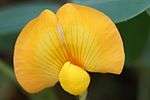
Peanut is an annual herbaceous plant growing 30 to 50 cm (12 to 20 in) tall.[14] As a legume, it belongs to the botanical family Fabaceae (also known as Leguminosae, and commonly known as the bean or pea family).[1] Like most other legumes, peanuts harbor symbiotic nitrogen-fixing bacteria in their root nodules.[5]
The leaves are opposite and pinnate with four leaflets (two opposite pairs; no terminal leaflet); each leaflet is 1 to 7 centimetres (1⁄2 to 2 3⁄4 in) long and 1 to 3 cm (1⁄2 to 1 1⁄4 in) across. Like those of many other legumes, the leaves are nyctinastic; that is, they have "sleep" movements, closing at night.
The flowers are 1 to 1.5 cm (3⁄8 to 5⁄8 in) across, and yellowish orange with reddish veining.[10][14] They are borne in axillary clusters on the stems above ground, and last for just one day. The ovary is located at the base of what appears to be the flower stem, but is actually a highly elongated floral cup.
Peanut pods develop underground, an unusual feature known as geocarpy.[15] After fertilization, a short stalk at the base of the ovary (termed a pedicel) elongates to form a thread-like structure known as a "peg". This peg grows down into the soil, and the tip, which contains the ovary, develops into a mature peanut pod.[15] Pods are 3 to 7 centimetres (1 to 3 in) long, normally containing one to four seeds.[10][14]
Parts
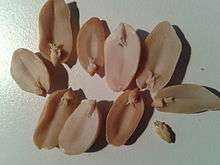
Parts of the peanut include:
- Shell - outer covering, in contact with dirt
- Cotyledons (two) - main edible part
- Seed coat - brown paper-like covering of the edible part
- Radicle - embryonic root at the bottom of the cotyledon, which can be snapped off
- Plumule - embryonic shoot emerging from the top of the radicle
Cultivation
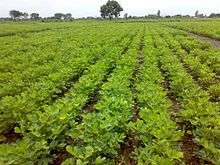
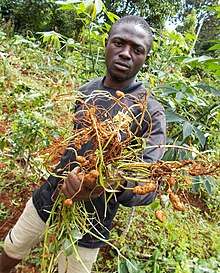
Peanuts grow best in light, sandy loam soil with a pH of 5.9–7. Their capacity to fix nitrogen means that, providing they nodulate properly, peanuts benefit little or not at all from nitrogen-containing fertilizer,[16] and they improve soil fertility. Therefore, they are valuable in crop rotations. Also, the yield of the peanut crop itself is increased in rotations, through reduced diseases, pests and weeds. For example, in Texas, peanuts in a three-year rotation with corn yield 50% more than nonrotated peanuts.[16] Adequate levels of phosphorus, potassium, calcium, magnesium, and micronutrients are also necessary for good yields.[16] To develop well, peanuts need warm weather throughout the growing season. They can be grown with as little as 350 mm (14 in) of water,[17] but for best yields need at least 500 mm (20 in).[18] Depending on growing conditions and the cultivar of peanut, harvest is usually 90 to 130 days after planting for subspecies A. h. fastigiata types, and 120 to 150 days after planting for subspecies A. h. hypogaea types.[17][19][20] Subspecies A. h. hypogaea types yield more, and are usually preferred where the growing seasons are sufficiently long.
Peanut plants continue to produce flowers when pods are developing; therefore even when they are ready for harvest, some pods are immature. In order to maximize yield, the timing of harvest is important. If it is too early, too many pods will be unripe; if too late, the pods will snap off at the stalk, and will remain in the soil.[21] For harvesting, the entire plant, including most of the roots, is removed from the soil.[21] The pods are covered with a network of raised veins and are constricted between seeds.
Harvesting occurs in two stages.[22] In mechanized systems, a machine is used to cut off the main root of the peanut plant by cutting through the soil just below the level of the peanut pods. The machine lifts the "bush" from the ground and shakes it, then inverts the bush, leaving the plant upside down on the ground to keep the peanuts out of the soil. This allows the peanuts to dry slowly to a little less than a third of their original moisture level over a period of three to four days. Traditionally, peanuts were pulled and inverted by hand.
After the peanuts have dried sufficiently, they are threshed, removing the peanut pods from the rest of the bush.[21] It is particularly important that peanuts are dried properly and stored in dry conditions. If they are too high in moisture, or if storage conditions are poor, they may become infected by the mold fungus Aspergillus flavus. Many strains of this fungus release toxic and highly carcinogenic substances called aflatoxins.
Cultivars in the United States
There are many peanut cultivars grown around the world. The market classes grown in the United States are Spanish, Runner, Virginia, and Valencia.[23] Peanut production in the United States is divided into three major areas: the southeastern United States region which includes Alabama, Georgia, and Florida; the southwestern United States region which includes New Mexico, Oklahoma, and Texas; and the third region in the general eastern United States which includes Virginia, North Carolina, and South Carolina.[23]
Certain cultivar groups are preferred for particular characteristics, such as differences in flavor, oil content, size, shape, and disease resistance.[22] Most peanuts marketed in the shell are of the Virginia type, along with some Valencias selected for large size and the attractive appearance of the shell. Spanish peanuts are used mostly for peanut candy, salted nuts, and peanut butter.
Spanish group
The small Spanish types are grown in South Africa, and in the southwestern and southeastern United States. Prior to 1940, 90% of the peanuts grown in the US state of Georgia were Spanish types, but the trend since then has been larger-seeded, higher-yielding, more disease-resistant cultivars. Spanish peanuts have a higher oil content than other types of peanuts. In the United States, the Spanish group is primarily grown in New Mexico, Oklahoma, and Texas.[23]
Cultivars of the Spanish group include 'Dixie Spanish', 'Improved Spanish 2B', 'GFA Spanish', 'Argentine', 'Spantex', 'Spanette', 'Shaffers Spanish', 'Natal Common (Spanish)', "White Kernel Varieties', 'Starr', 'Comet', 'Florispan', 'Spanhoma', 'Spancross', 'OLin', 'Tamspan 90', 'AT 9899–14', 'Spanco', 'Wilco I', 'GG 2', 'GG 4', 'TMV 2', and 'Tamnut 06'.
Runner group
Since 1940, the southeastern US region has seen a shift to production of Runner group peanuts. This shift is due to good flavor, better roasting characteristics and higher yields when compared to Spanish types, leading to food manufacturers' preference for the use in peanut butter and salted nuts. Georgia's production is now almost 100% Runner type.[22]
Cultivars of Runners include 'Southeastern Runner 56-15', 'Dixie Runner', 'Early Runner', 'Virginia Bunch 67', 'Bradford Runner', 'Egyptian Giant' (also known as 'Virginia Bunch' and 'Giant'), 'Rhodesian Spanish Bunch' (Valencia and Virginia Bunch), 'North Carolina Runner 56-15', 'Florunner', 'Virugard', 'Georgia Green', 'Tamrun 96', 'Flavor Runner 458', 'Tamrun OL01', 'Tamrun OL02' 'AT-120', 'Andru-93', 'Southern Runner', 'AT1-1', 'Georgia Brown', 'GK-7', and 'AT-108'.
Virginia group
The large-seeded Virginia group peanuts are grown in the US states of Virginia, North Carolina, Tennessee, Texas, New Mexico, Oklahoma, and parts of Georgia. They are increasing in popularity due to demand for large peanuts for processing, particularly for salting, confections, and roasting in the shells.
Virginia group peanuts are either bunch or running in growth habit. The bunch type is upright to spreading. It attains a height of 45 to 55 cm (18 to 22 in), and a spread of 70 to 80 cm (28 to 31 in), with 80 to 90 cm (31 to 35 in) rows that seldom cover the ground. The pods are borne within 5 to 10 cm (2 to 4 in) of the base of the plant.
Cultivars of Virginia type peanuts include 'NC 7', 'NC 9', 'NC 10C', 'NC-V 11', 'VA 93B', 'NC 12C', 'VA-C 92R', 'Gregory', 'VA 98R', 'Perry', 'Wilson, 'Hull', 'AT VC-2' and' Shulamit'.
Valencia group
Valencia group peanuts are coarse, and they have heavy reddish stems and large foliage. In the United States, large commercial production is primarily in the South Plains of West Texas, and in eastern New Mexico near and south of Portales, but they are grown on a small scale elsewhere in the South as the best-flavored and preferred type for boiled peanuts. They are comparatively tall, reaching a height of 125 cm (49 in) and a spread of 75 cm (30 in). Peanut pods are borne on pegs arising from the main stem and the side branches. Most of the pods are clustered around the base of the plant, and only a few are found several inches away. Valencia types are three- to five-seeded and smooth, with no constriction of the shell between the seeds. Seeds are oval and tightly crowded into the pods. Typical seed weight is 0.4 to 0.5 g. This type is used heavily for sale roasted and salted in-shell peanuts, and for peanut butter. Varieties include 'Valencia A' and 'Valencia C'.
Tennessee Red and Tennessee White groups
These are alike, except for the color of the seed. Sometimes known also as Texas Red or White, the plants are similar to Valencia types, except the stems are green to greenish brown, and the pods are rough, irregular, and have a smaller proportion of kernels.
Production and trade
| Peanut production, 2017 (millions of tonnes) | |
|---|---|
| Country | Production |
| 17.1 | |
| 9.2 | |
| 3.3 | |
| 2.4 | |
| 1.6 | |
| 1.6 | |
| World | 47.1 |
| Source: FAOSTAT, United Nations[13] | |
In 2017, world production of peanuts (reported as groundnuts in shells) was 47 million tonnes, led by China with 36% of the global total, followed by India (20%). Other significant producers were the United States, Nigeria, Myanmar, and Sudan. Major exporters in 2017 were India with 601,849 tonnes, which accounts for 32% of world total exports (1.9 million tonnes), and the United States with 16% of total exports.[24]
Food
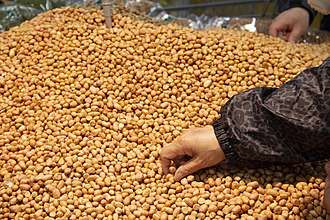
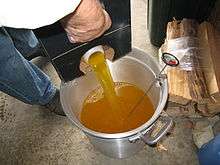
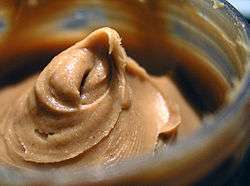
Whole peanuts
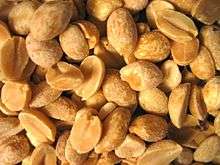
Dry-roasting peanuts is a common form of preparation. Dry peanuts can be roasted in the shell or shelled in a home oven if spread out one layer deep in a pan and baked at a temperature of 350 °F or 177 °C for 15 to 20 min (shelled) and 20 to 25 min (in shell).
Boiled peanuts are a popular snack in India, China, West Africa, and the southern United States. In the US South, boiled peanuts are often prepared in briny water, and sold in streetside stands.
A distinction can be drawn between raw and green peanuts. A green peanut is a term to describe farm fresh harvested peanuts that have not been dehydrated. They are available from grocery stores, food distributors and farmers markets, during the growing season. "Raw" peanuts are also uncooked but have been dried/dehydrated and must be rehydrated before boiling (usually in a bowl full of water overnight). Once rehydrated, the raw peanuts are ready to be boiled.[25]
Peanut oil
Peanut oil is often used in cooking, because it has a mild flavor and a relatively high smoke point. Due to its high monounsaturated content, it is considered more healthful than saturated oils, and is resistant to rancidity. The several types of peanut oil include aromatic roasted peanut oil, refined peanut oil, extra virgin or cold-pressed peanut oil, and peanut extract. In the United States, refined peanut oil is exempt from allergen labeling laws.[26]
Peanut butter
Peanut butter is a food paste or spread made from ground dry roasted peanuts. It often contains additional ingredients that modify the taste or texture, such as salt, sweeteners or emulsifiers. Peanut butter is served as a spread on bread, toast or crackers, and used to make sandwiches (notably the peanut butter and jelly sandwich). It is also used in a number of confections, such as peanut-flavored granola bars or croissants and other pastries. The United States[27] is a leading exporter of peanut butter, and itself consumes $800 million of peanut butter annually.[28]
Peanut flour
Peanut flour is used in gluten-free cooking.
Cuisine
.jpg)
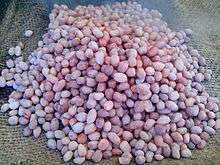
Latin America
Peanuts are particularly common in Peruvian and Mexican cuisine, both of which marry indigenous and European ingredients. For instance, in Peru, a popular traditional dish is picante de cuy,[29] a roasted guinea pig served in a sauce of ground peanuts (ingredients native to South America) with roasted onions and garlic (ingredients from European cuisine). Also, in the Peruvian city of Arequipa, a dish called ocopa consists of a smooth sauce of roasted peanuts and hot peppers (both native to the region) with roasted onions, garlic, and oil, poured over meat or potatoes.[30] Another example is a fricassee combining a similar mixture with sautéed seafood or boiled and shredded chicken. These dishes are generally known as ajíes, meaning "hot peppers", such as ají de pollo and ají de mariscos (seafood ajíes may omit peanuts). In Mexico its is also used to prepare different traditional dishes, such as chicken in peanut sauce (encacahuatado) and is used as a main ingredient for the preparation of other famous dishes such as red pipián, mole poblano and oaxacan mole negro. [31]
Likewise, during colonial times in Peru, the Spanish used peanuts to replace nuts unavailable locally, but used extensively in Spanish cuisine, such as almonds and pine nuts, typically ground or as paste mixed with rice, meats, and vegetables for dishes like rice pilaf.
Throughout the region, many candies and snacks are made using peanuts. In Mexico, it is common to find them in different presentations as a snack or candy: salty, "Japanese" peanuts, praline, enchilados or in the form of a traditional sweet made with peanuts and honey called palanqueta, and even as peanut marzipan.
West Asia
Crunchy coated peanuts, called kabukim in Hebrew, are a popular snack in Israel. Kabukim are commonly sold by weight at corner stores where fresh nuts and seeds are sold, though they are also available packaged. The coating typically consists of flour, salt, starch, lecithin, and sometimes sesame seeds. The origin of the name is obscure (it may be derived from kabuk which means nutshell or husk in Turkish). An additional variety of crunchy coated peanuts popular in Israel is "American peanuts". The coating of this variety is thinner, but harder to crack.
Bamba puffs are a popular snack in Israel. Their shape is similar to Cheez Doodles, but they are made of peanuts and corn.
Southeast Asia
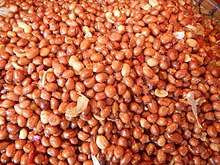
Peanuts are also widely used in Southeast Asian cuisine, such as in Malaysia, Vietnam, and Indonesia, where they are typically made into a spicy sauce. Peanuts originally came to Indonesia from the Philippines, where the legume derived from Mexico in times of Spanish colonization. One Philippine dish using peanuts is kare-kare, a mixture of meat and peanut butter. Apart from being used in dishes, fried shelled peanuts are a common inexpensive snack in the Philippines with the peanuts commonly served plain salted with garlic chips and variants including adobo and chilli flavors.
Common Indonesian peanut-based dishes include gado-gado, pecel, karedok, and ketoprak, vegetable salads mixed with peanut sauce, and the peanut-based sauce, satay.
Indian subcontinent
In the Indian subcontinent, peanuts are a light snack, usually roasted and salted (sometimes with the addition of chilli powder), and often sold roasted in pods or boiled with salt. They are also made into dessert or sweet snack pieces by processing with refined sugar and jaggery. Indian cuisine uses roasted, crushed peanuts to give a crunchy body to salads; they are added whole (without pods) to leafy vegetable stews for the same reason. Another use is peanut oil for cooking. Most Indians use mustard, sunflower, and peanut oil for cooking. In South India, groundnut chutney is eaten with dosa and idli as breakfast. Peanuts are also used in sweets and savory items in South India and also as a flavor in tamarind rice. Kovilpatti is known for its sweet peanut chikki, which is also used in savory and sweet mixtures, such as Bombay mix.
West Africa
Peanuts grow well in southern Mali and adjacent regions of the Ivory Coast, Burkina Faso, Ghana, Nigeria, and Senegal; peanuts are similar in both agricultural and culinary qualities to the Bambara groundnut native to the region, and West Africans have adopted the crop as a staple. Peanut sauce, prepared with onions, garlic, peanut butter/paste, and vegetables such as carrots, cabbage, and cauliflower, can be vegetarian (the peanuts supplying ample protein) or prepared with meat, usually chicken.
Peanuts are used in the Malian meat stew maafe. In Ghana, peanut butter is used for peanut butter soup nkate nkwan.[32] Crushed peanuts may also be used for peanut candies nkate cake and kuli-kuli, as well as other local foods such as oto.[32] Peanut butter is an ingredient in Nigeria's "African salad". Peanut powder is an important ingredient in the spicy coating for kebabs in Nigeria and Ghana.
East Africa
Peanuts are a common ingredient of several types of relishes (dishes which accompany nshima) eaten in Malawi and in the eastern part of Zambia, and these dishes are common throughout both countries. Thick peanut butter sauces are also made in Uganda to serve with rice and other starchy foods. Groundnut stew, called ebinyebwa in Luganda-speaking areas of Uganda, is made by boiling ground peanut flour with other ingredients, such as cabbage, mushrooms, dried fish, meat or other vegetables.[33] Across East Africa, roasted peanuts, often in cones of newspaper, are obtained from street vendors.
North America
In Canada and the United States, peanuts are used in candies, cakes, cookies, and other sweets. Individually, they are eaten dry-roasted with or without salt. Ninety-five percent of Canadians eat peanuts or peanut butter, with average consumption of 3 kilograms (6 1⁄2 lb) of peanuts per person annually, and 79% of Canadians consuming peanut butter weekly.[34] In the United States, peanuts and peanut butter are central to American dietary practices, and are typically considered as comfort foods.[35] Peanut butter is a common peanut-based food, representing half of American total peanut consumption and $850 million in annual retail sales.[36] Peanut soup is found on restaurant menus in the southeastern states.[37] In some southern portions of the US, peanuts are boiled for several hours until soft and moist.[38] Peanuts are also deep-fried, sometimes within the shell. Per person, Americans eat 2.7 kg (6 lb) of peanut products annually, spending a total of $2 billion in peanut retail purchases.[36]
Malnutrition
Peanuts are used to help fight malnutrition. Plumpy Nut, MANA Nutrition,[39] and Medika Mamba[40] are high-protein, high-energy, and high-nutrient peanut-based pastes developed to be used as therapeutic food to aid in famine relief. The World Health Organization, UNICEF, Project Peanut Butter, and Doctors Without Borders have used these products to help save malnourished children in developing countries.
Peanuts can be used like other legumes and grains to make a lactose-free, milk-like beverage, peanut milk, which is promoted in Africa as a way to reduce malnutrition among children.
Animal feed
Peanut plant tops and crop residues can be used for hay.[41]
The protein cake (oilcake meal) residue from oil processing is used as an animal feed and as a soil fertilizer. Groundnut cake is a livestock feed, mostly used by cattle as protein supplements.[42] It is one of the most important and valuable feed for all types of livestocks and one of the most active ingredient for poultry rations.[43] Poor storage of the cake may sometimes result in its contamination by aflatoxin, a naturally occurring mycotoxin that is produced by Aspergillus flavus and Aspergillus parasiticus.[44] The major constituents of the cake are essential amino acids such as lysine and glutamine. Other components are crude fiber, crude protein, and fat.
Some peanuts can also be fed whole to livestock, for example those in excess of the peanut quota in the US, or those with a higher aflatoxin content than that permitted by the food regulations.[45]
Peanut processing often requires dehulling: the hulls generated in large amounts by the peanut industries can then be used to feed livestock, particularly ruminants.[46]
Industrial use
Peanuts have a variety of industrial end uses. Paint, varnish, lubricating oil, leather dressings, furniture polish, insecticides, and nitroglycerin are made from peanut oil. Soap is made from saponified oil, and many cosmetics contain peanut oil and its derivatives. The protein portion is used in the manufacture of some textile fibers. Peanut shells are used in the manufacture of plastic, wallboard, abrasives, fuel, cellulose (used in rayon and paper), and mucilage (glue).
Nutritional value
| Nutritional value per 100 g (3.5 oz) | |
|---|---|
| Energy | 2,385 kJ (570 kcal) |
21 g | |
| Sugars | 0.0 g |
| Dietary fiber | 9 g |
48 g | |
| Saturated | 7 g |
| Monounsaturated | 24 g |
| Polyunsaturated | 16 g |
25 g | |
| Tryptophan | 0.2445 g |
| Threonine | 0.859 g |
| Isoleucine | 0.882 g |
| Leucine | 1.627 g |
| Lysine | 0.901 g |
| Methionine | 0.308 g |
| Cystine | 0.322 g |
| Phenylalanine | 1.300 g |
| Tyrosine | 1.020 g |
| Valine | 1.052 g |
| Arginine | 3.001 g |
| Histidine | 0.634 g |
| Alanine | 0.997 g |
| Aspartic acid | 3.060 g |
| Glutamic acid | 5.243 g |
| Glycine | 1.512 g |
| Proline | 1.107 g |
| Serine | 1.236 g |
| Vitamins | Quantity %DV† |
| Thiamine (B1) | 52% 0.6 mg |
| Riboflavin (B2) | 25% 0.3 mg |
| Niacin (B3) | 86% 12.9 mg |
| Pantothenic acid (B5) | 36% 1.8 mg |
| Vitamin B6 | 23% 0.3 mg |
| Folate (B9) | 62% 246 μg |
| Vitamin C | 0% 0.0 mg |
| Vitamin E | 44% 6.6 mg |
| Minerals | Quantity %DV† |
| Calcium | 6% 62 mg |
| Iron | 15% 2 mg |
| Magnesium | 52% 184 mg |
| Manganese | 95% 2.0 mg |
| Phosphorus | 48% 336 mg |
| Potassium | 7% 332 mg |
| Zinc | 35% 3.3 mg |
| Other constituents | Quantity |
| Water | 4.26 g |
| |
| †Percentages are roughly approximated using US recommendations for adults. | |
Peanuts are rich in essential nutrients (right table, USDA nutrient data). In a 100 g serving, peanuts provide 570 calories and are an excellent source (defined as more than 20% of the Daily Value, DV) of several B vitamins, vitamin E, several dietary minerals, such as manganese (95% DV), magnesium (52% DV) and phosphorus (48% DV), and dietary fiber (right table). They also contain about 25 g protein per 100 g serving, a higher proportion than in many tree nuts.[47]
Some studies show that regular consumption of peanuts is associated with a lower specific risk of mortality from certain diseases.[48][49] However, the study designs do not allow cause and effect to be inferred. According to the US Food and Drug Administration, "Scientific evidence suggests but does not prove that eating 1.5 ounces per day of most nuts (such as peanuts) as part of a diet low in saturated fat and cholesterol may reduce the risk of heart disease."[50]
Phytochemicals
Peanuts contain polyphenols, polyunsaturated and monounsaturated fats, phytosterols and dietary fiber in amounts similar to several tree nuts.[49]
Peanut skins contain resveratrol which is under preliminary research for its potential effects in humans.[51][52]
Oil composition
A common cooking and salad oil, peanut oil is 46% monounsaturated fats (primarily oleic acid), 32% polyunsaturated fats (primarily linoleic acid), and 17% saturated fats (primarily palmitic acid).[53][54] Extractable from whole peanuts using a simple water and centrifugation method, the oil is being considered by NASA's Advanced Life Support program for future long-duration human space missions.[55]
Health concerns
Allergies
Some people (0.6%[56] of the United States population) report that they experience allergic reactions to peanut exposure; symptoms are specifically severe for this nut, and can range from watery eyes to anaphylactic shock, which is generally fatal if untreated. Eating a small amount of peanut can cause a reaction. Because of their widespread use in prepared and packaged foods, the avoidance of peanuts can be difficult. The reading of ingredients and warnings on product packaging is necessary to avoid this allergen. Foods that are processed in facilities which also handle peanuts on the same equipment as other foods are required to carry such warnings on their labels. Avoiding cross contamination with peanuts and peanut products, (along with other severe allergens like shellfish) is a promoted and common practice which chefs and restaurants worldwide are becoming aware of.
The hygiene hypothesis of allergy states that a lack of early childhood exposure to infectious agents like germs and parasites could be causing the increase of food allergies.[57]
Studies comparing age of peanut introduction in Great Britain with introduction in Israel showed that delaying exposure to peanuts in childhood can dramatically increase the risk of developing peanut allergies.[58][59]
Peanut allergy has been associated with the use of skin preparations containing peanut oil among children, but the evidence is not regarded as conclusive.[60] Peanut allergies have also been associated with family history and intake of soy products.[60]
Some school districts in the United States and elsewhere have banned peanuts.[61][62][63] However, the efficacy of the bans in reducing allergic reactions is uncertain. A recent study in Canada has shown that there is no difference in the percentage of accidental exposures occurring in schools prohibiting peanuts than in schools allowing them.[64]
Refined peanut oil will not cause allergic reactions in most people with peanut allergies.[65] However, crude (unrefined) peanut oils have been shown to contain protein, which may cause allergic reactions.[66] In a randomized, double-blind crossover study, 60 people with proven peanut allergy were challenged with both crude peanut oil and refined peanut oil. The authors concluded, "Crude peanut oil caused allergic reactions in 10% of allergic subjects studied and should continue to be avoided." They also stated, "Refined peanut oil does not seem to pose a risk to most people with peanut allergy." However, they point out that refined peanut oil can still pose a risk to peanut-allergic individuals if oil that has previously been used to cook foods containing peanuts is reused.[67]
Contamination with aflatoxin
If peanut plants are subjected to severe drought during pod formation, or if pods are not properly stored, they may become contaminated with the mold Aspergillus flavus which may produce carcinogenic substances called aflatoxins. Lower-quality peanuts, particularly where mold is evident, are more likely to be contaminated.[68] The United States Department of Agriculture tests every truckload of raw peanuts for aflatoxin; any containing aflatoxin levels of more than 15 parts per billion are destroyed. The peanut industry has manufacturing steps in place to ensure all peanuts are inspected for aflatoxin.[69] Peanuts tested to have high aflatoxin are used to make peanut oil where the mold can be removed.[70]
Gallery
 A warning sign for the presence of peanuts and peanut dust
A warning sign for the presence of peanuts and peanut dust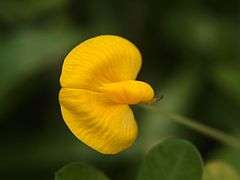 Arachis hypogaea flower
Arachis hypogaea flower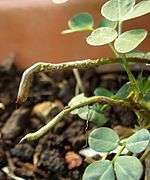 Peanut pegs penetrating the ground
Peanut pegs penetrating the ground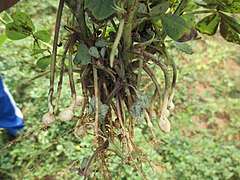 Developing pods of peanut
Developing pods of peanut- Track-type peanut harvester
.jpg) Harvesting peanuts by hand
Harvesting peanuts by hand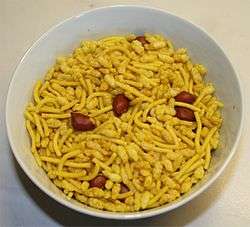 A bowl of sev mamra, consisting of puffed rice, peanuts and fried seasoned noodles
A bowl of sev mamra, consisting of puffed rice, peanuts and fried seasoned noodles
See also
- African Groundnut Council
- BBCH-scale (peanut)
- Beer Nuts
- Columbian exchange
- Cracker nuts
- Ground nut soup
- List of peanut dishes
- List of edible seeds
- Peanut pie
- Power snack
- Tanganyika groundnut scheme, a failure started in 1951
- Universal Nut Sheller
References
- "The Plant List: A Working List of All Plant Species". Royal Botanic Gardens, Kew and Missouri Botanical Garden. 2013. Retrieved February 13, 2015.
- USDA GRIN Taxonomy, retrieved June 29, 2016
- "Grain Legumes". www.hort.purdue.edu. Retrieved September 29, 2015.
- "Oil crops for production of advanced biofuels". European Biofuels Technology Platform. Archived from the original on September 9, 2015. Retrieved September 28, 2015.
- "Legumes Of The World | Royal Botanic Gardens, Kew". www.kew.org. Retrieved September 29, 2015.
- "The Peanut Institute – Peanut Facts". peanut-institute.org. Archived from the original on April 8, 2019.
- Seijo, Guillermo; Graciela I. Lavia; Aveliano Fernandez; Antonio Krapovickas; Daniel A. Ducasse; David J. Bertioli; Eduardo A. Moscone (December 1, 2007). "Genomic relationships between the cultivated peanut (Arachis hypogaea, Leguminosae) and its close relatives revealed by double GISH". American Journal of Botany. 94 (12): 1963–1971. doi:10.3732/ajb.94.12.1963. PMID 21636391. Retrieved July 5, 2010.
- Kochert, Gary; Stalker, H. Thomas; Gimenes, Marcos; Galgaro, Leticia; Lopes, Catalina Romero; Moore, Kim (October 1, 1996). "RFLP and Cytogenetic Evidence on the Origin and Evolution of Allotetraploid Domesticated Peanut, Arachis hypogaea (Leguminosae)". American Journal of Botany. 83 (10): 1282–1291. doi:10.2307/2446112. JSTOR 2446112.
- Moretzsohn, Márcio C.; Gouvea, Ediene G.; Inglis, Peter W.; Leal-Bertioli, Soraya C.M.; Valls, José F.M.; Bertioli, David J. (January 1, 2013). "A study of the relationships of cultivated peanut (Arachis hypogaea) and its most closely related wild species using intron sequences and microsatellite markers". Annals of Botany. 111 (1): 113–126. doi:10.1093/aob/mcs237. ISSN 0305-7364. PMC 3523650. PMID 23131301.
- Krapovickas, Antonio; Gregory, Walton C. (2007). translated by David E. Williams and Charles E. Simpson. "Taxonomy of the genus Arachis (Leguminosae)" (PDF). IBONE. 16 (Supl.): 1–205.
- Dillehay, Tom D. "Earliest-known evidence of peanut, cotton and squash farming found". Retrieved June 29, 2007.
- Berrin, Katherine & Larco Museum. The Spirit of Ancient Peru: Treasures from the Museo Arqueológico Rafael Larco Herrera. New York: Thames & Hudson, 1997.
- "Peanut (groundnuts with shell) production in 2017". FAOSTAT, Food and Agricultural Organization of the United Nations, Statistics Division. 2018. Retrieved November 11, 2019.
- Putnam, D.H., et al. (1991) Peanut. University of Wisconsin-Extension Cooperative Extension: Alternative Field Crops Manual.
- Smith, Ben W. (January 1, 1950). "Arachis hypogaea. Aerial Flower and Subterranean Fruit". American Journal of Botany. 37 (10): 802–815. doi:10.2307/2437758. JSTOR 2437758.
- Baughman, Todd; Grichar, James; Black, Mark; Woodward, Jason; Porter, Pat; New, Leon; Baumann, Paul; McFarland, Mark "Texas Peanut Production Guide" (PDF). Texas A&M University. Retrieved October 16, 2015
- Schilling, Robert (February 5, 2003). "L'arachide histoire et perspectives". L'arachide histoire et perspectives. Agropolis Museum. Retrieved October 16, 2015.
- Jauron, Richard (February 5, 1997). "Growing Peanuts in the Home Garden | Horticulture and Home Pest News". Ipm.iastate.edu. Retrieved May 30, 2011.
- Marsalis, Mark; Puppala, Naveen; Goldberg, Natalie; Ashigh, Jamshid; Sanogo, Soumaila; Trostle, Calvin (July 2009). "New Mexico Peanut Production" (PDF). Circular-645. New Mexico State University. Retrieved October 16, 2015.
- "Peanut". www.hort.purdue.edu. Retrieved October 16, 2015.
- "How peanuts are Grown – Harvesting – PCA". Peanut Company of Australia. Archived from the original on July 19, 2008. Retrieved May 30, 2011.
- Bilello, Stanley (October 10, 2016). 21st Century Homestead: Nitrogen-Fixing Crops. Lulu.com. pp. 93–94. ISBN 9781365452901.
- Ruark, Elinor. "Peanut Cultivars and Descriptions". caes2.caes.uga.edu. Retrieved November 22, 2016.
- "Export quantities for 'Groundnuts shelled' in 2017; Crops and livestock products; pick lists for Regions/World list/Export quantity". FAOSTAT, Food and Agricultural Organization of the United Nations, Statistics Division. 2017. Retrieved November 11, 2019.
- Boiled Peanuts Questions and Answers at The Lee Bros. Catalogue. Retrieved 30 October 2011.
- "Food Allergen Labeling and Consumer Protection Act of 2004 (Public Law 108-282, Title II)". Fda.gov. Retrieved May 30, 2011.
- "U.S. Exports of (NAICS 311911) Roasted Nuts & Peanut Butter With All Countries]". US Census Bureau. 2012. Archived from the original on June 19, 2015.
- Chakravorty, Rup. "Breeding a better peanut butter". American Society of Agronomy. Archived from the original on November 10, 2015. Retrieved October 15, 2015.
- "Gastronomía de Huánuco - Platos típicos - Pachamanca Picante de cuy". www.huanuco.com. Retrieved October 26, 2015.
- "Menú, recetas, cocina, nutricion | Menú Perú". menuperu.elcomercio.pe. Retrieved October 26, 2015.
- "Demystifying mole, Mexico's national dish". www.mexconnect.com. Retrieved August 20, 2010.
- Ghanaian cuisine
- "Ebinyebwa; a tale of the Ugandan groundnut stew". Daily Monitor/Monitor Publications Ltd, Kampala, Uganda. April 8, 2008. Retrieved December 28, 2015.
- "Peanuts in Canada". Peanut Bureau of Canada. 2017. Retrieved December 6, 2017.
- Karina Martinez-Carter (February 14, 2014). "As American as peanut butter". Pacific Standard. Retrieved December 6, 2017.
- "History of Peanuts & Peanut Butter". US National Peanut Board. 2017. Retrieved December 6, 2017.
- "The history of peanut soup". The Virginia Marketplace. September 19, 2012. Retrieved December 6, 2017.
- "16 Fun Facts about Peanuts & Peanut Butter; Number 13". US National Peanut Board. 2017. Retrieved December 6, 2017.
- Raymond, Bret. "Rwaza Health Centre: Efficacy Study Results" (PDF). MANA Nutrition. Retrieved July 15, 2011.
- "Meds & Food For Kids :: — Medika Mamba". mfkhaiti.org. Archived from the original on April 8, 2010. Retrieved April 23, 2010.
- Heuzé V., Thiollet H., Tran G., Lebas F., 2017. Peanut forage. Feedipedia, a programme by INRA, CIRAD, AFZ and FAO. https://www.feedipedia.org/node/695
- Deshpande, S. S. (2000). Fermented Grain Legumes, Seeds and Nuts. ISBN 9789251044445. Retrieved May 25, 2015.
- "Palm kernel meal as a feed for poultry. 1. Composition of palm". Journal of Animal feed science. Retrieved May 25, 2015.
- "3. Feed values and feeding potential of major agro-byproducts". fao.org. Retrieved May 25, 2015.
- Heuzé V., Thiollet H., Tran G., Bastianelli D., Lebas F., 2017. Peanut seeds. Feedipedia, a programme by INRA, CIRAD, AFZ and FAO. https://www.feedipedia.org/node/55
- Heuzé V., Thiollet H., Tran G., Edouard N., Bastianelli D., Lebas F., 2017. Peanut hulls. Feedipedia, a programme by INRA, CIRAD, AFZ and FAO. https://www.feedipedia.org/node/696
- "Nutrition facts for peanuts, all types, raw, USDA Nutrient Data". Conde Nast, USDA National Nutrient Database, version SR-21. 2014. Retrieved January 15, 2015.
- Bao, Ying; Han, Jiali; Hu, Frank B.; Giovannucci, Edward L.; Stampfer, Meir J.; Willett, Walter C.; Fuchs, Charles S. (November 21, 2013). "Association of Nut Consumption with Total and Cause-Specific Mortality". New England Journal of Medicine. 369 (21): 2001–2011. doi:10.1056/NEJMoa1307352. ISSN 0028-4793. PMC 3931001. PMID 24256379.
- "Nuts (including peanuts)". Micronutrient Information Center. Corvallis, OR: Linus Pauling Institute, Oregon State University. 2009. Retrieved November 29, 2016.
- Taylor CL (July 14, 2003). "Qualified Health Claims: Letter of Enforcement Discretion – Nuts and Coronary Heart Disease (Docket No 02P-0505)". Center for Food Safety and Applied Nutrition, FDA. Retrieved October 14, 2015.
- "Resveratrol". Micronutrient Information Center. Corvallis, OR: Linus Pauling Institute, Oregon State University. 2016.
- Sales, J. M.; Resurreccion, A. V. (2014). "Resveratrol in peanuts". Critical Reviews in Food Science and Nutrition. 54 (6): 734–70. doi:10.1080/10408398.2011.606928. PMID 24345046.
- "Nutrition facts for oil, peanut, salad or cooking, USDA Nutrient Data". Conde Nast, USDA National Nutrient Database, version SR-21. 2014. Retrieved January 15, 2015.
- Ozcan MM (2010). "Some nutritional characteristics of kernel and oil of peanut (Arachis hypogaea L.)". J Oleo Sci. 59 (1): 1–5. doi:10.5650/jos.59.1. PMID 20032593.
- Shi L, Lu JY, Jones G, Loretan PA, Hill WA (1998). "Characteristics and composition of peanut oil prepared by an aqueous extraction method". Life Support Biosph Sci. 5 (2): 225–9. PMID 11541680.CS1 maint: uses authors parameter (link)
- "Food Allergy Quick Facts". National Institute of Allergy and Infectious Diseases. February 24, 2012. Retrieved January 30, 2014.
- "Peanut Allergy on the Rise: Why?". WebMD. May 14, 2010. Retrieved May 18, 2010.
- Food allergy advice may be peanuts, Science News, December 6, 2008
- Høst, A; Halken, S; Muraro, A; Dreborg, S; Niggemann, B; Aalberse, R; Arshad, SH; Von Berg, A; et al. (2008). "Dietary prevention of allergic diseases in infants and small children". Pediatric Allergy and Immunology. 19 (1): 1–4. doi:10.1111/j.1399-3038.2007.00680.x. PMID 18199086.
- Lack G, Fox D, Northstone K, Golding J (2003). "Factors Associated with the Development of Peanut Allergy in Childhood". New England Journal of Medicine. 348 (11): 977–85. doi:10.1056/NEJMoa013536. PMID 12637607.
- Hartocollis, Anemona (September 23, 1998). "Nothing's Safe: Some Schools Ban Peanut Butter as Allergy Threat". The New York Times. Retrieved August 18, 2009.
- Nevius, C.W. (September 9, 2003). "One 5-year-old's allergy leads to class peanut ban". San Francisco Chronicle. Retrieved August 18, 2009.
- "School peanut ban in need of review". Nashua Telegraph. September 14, 2008. Retrieved August 18, 2009.
- Cherkaoui, Sabrine; Ben-Shoshan, Moshe; Alizadehfar, Reza; Asai, Yuka; Chan, Edmond; Cheuk, Stephen; Shand, Greg; St-Pierre, Yvan; Harada, Laurie (January 1, 2015). "Accidental exposures to peanut in a large cohort of Canadian children with peanut allergy". Clinical and Translational Allergy. 5: 16. doi:10.1186/s13601-015-0055-x. ISSN 2045-7022. PMC 4389801. PMID 25861446.
- "The anaphylaxis campaign: peanut oil". Anaphylaxis.org.uk. Archived from the original on April 18, 2008. Retrieved August 18, 2009.
- Hoffman DR, Collins-Williams C (1994). "Cold-pressed peanut oils may contain peanut allergen". The Journal of Allergy and Clinical Immunology. 93 (4): 801–2. doi:10.1016/0091-6749(94)90262-3. PMID 8163791.
- Hourihane JO, Bedwani SJ, Dean TP, Warner JO (1997). "Randomised, double blind, crossover challenge study of allergenicity of peanut oils in subjects allergic to peanuts". BMJ. 314 (7087): 1084–8. doi:10.1136/bmj.314.7087.1084. PMC 2126478. PMID 9133891.
- Hirano, S; Shima, T; Shimada, T (August 2001). "[Proportion of aflatoxin B1 contaminated kernels and its concentration in imported peanut samples]". Shokuhin Eiseigaku Zasshi. 42 (4): 237–42. doi:10.3358/shokueishi.42.237. PMID 11817138.
- 7 CFR 2011 – Part 996a
- "Why Georgia farmers decided to shell their own peanuts". New Food Economy. April 26, 2017. Retrieved July 4, 2019.